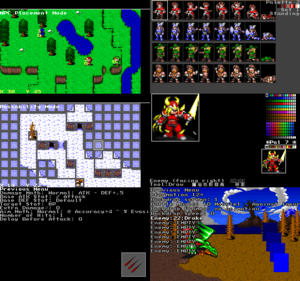OHRRPGCE
| OHRRPGCE
|
|
|---|---|
|
Various screenshots of the OHRRPGCE |
|
| Basic data
|
|
| developer | James Paige |
| Publishing year | 1997 |
| Current version | Fufluns (January 12, 2020) |
| operating system | Windows , Linux , macOS , Android |
| programming language | FreeBasic |
| category | Game engine |
| License | GPL |
| German speaking | No |
| OHRRPGCE Wiki | |
OHRRPGCE is a free game engine for creating classic 2D computer role-playing games , which has been further developed since 1996. The purpose of this program is to be able to create your own computer games as easily as possible and without programming knowledge.
Name and story
The complicated abbreviation stands for O fficial H amster R epublic R ole P laying G ame C onstruction E ngine (Official role-playing program of the Hamster Republic). The program writer, James Paige, wanted to make fun of the trend towards shortening words. A hamster named Bob has been the official mascot since the OHRRPGCE was first published in 1997 .
Originally in QuickBasic for MS-DOS written, the engine distributed over the early Internet , especially in the American space that dominates the community in proportion to this day. Initially, the distribution of the full version was limited, so capable game designers had to show their skills in a limited demo version and then got access to the correct version. So the game quality should be kept high, but the model was soon bypassed by copies on the Internet.
In 2005 the authors decided to release the old QuickBASIC source code under the GPL . Developers quickly came together who undertook a porting to FreeBASIC and thus kept the OHRRPGCE running on newer operating systems. Since then, the program has grown in terms of its possibilities without differing drastically from the original version. From 2017, for example, it was possible to control games with the mouse . In 2019, support for Windows 95 was resumed as the engine's hardware requirements have increased only minimally since its inception.
features
The most important idea of the OHRRPGCE was to make the development of role play games as easy as possible. This is the purpose of the Custom.exe editor , in which everything necessary for a role-playing game can be edited, such as graphics, attacks, opponents, fights, items and dialogues. No programming language has to be mastered, but more complex game sections can be designed with the in-house HamsterSpeak scripts.
The games created are tried out with the second part of the OHRRPGCE, Game.exe . Graphically, the OHRRPGCE remains at the level of the early nineties, so that each figure can only consist of 16 colors from a palette of a maximum of 256 colors. Until 2013, the standard resolution was 320 × 200, the original of the Mode X graphics library used in the DOS engine . This, like the original 20 × 20 pixel field size per area, can now be adjusted.
In terms of other options, such as the Active ATB ( Active Time Battle ) system, OHRRPGCE games are similar to early titles in the Final Fantasy series (IV – VI) for the Super Nintendo . Resourceful developers, however, have come up with their own combat systems or their own game mechanics to create side scrollers , pseudo-3D dungeon crawlers or economic simulations with the engine, which was actually only designed for RPGs.
Community
The English-speaking OHRRPGCE community has existed since the late 1990s. Some of the games developed are published in the indie sector and, for example, commercially on Steam , but most of them are free in Internet forums or on private homepages . Some of the more popular games include:
- Wandering Hamster (the first OHRRPGCE game)
- Arfenhouse (has a place in meme culture )
- Vikings of Midgard (included with the engine as an example)
- C. Kane (released on Steam)
- Kaiju Big Battel: Fighto Fantasy (released on Steam)
- Alien Squatter (released on Steam)
Web links
- EAR Wiki (English)
- OHRRPGCE Community (English)
